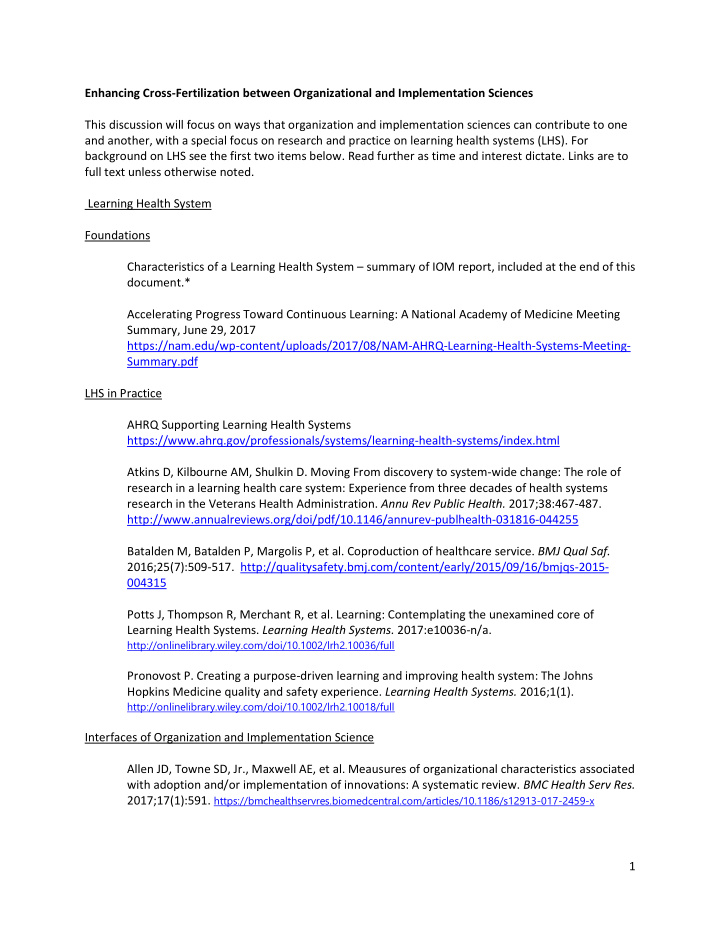



Enhancing Cross-Fertilization between Organizational and Implementation Sciences This discussion will focus on ways that organization and implementation sciences can contribute to one and another, with a special focus on research and practice on learning health systems (LHS). For background on LHS see the first two items below. Read further as time and interest dictate. Links are to full text unless otherwise noted. Learning Health System Foundations Characteristics of a Learning Health System – summary of IOM report, included at the end of this document.* Accelerating Progress Toward Continuous Learning: A National Academy of Medicine Meeting Summary, June 29, 2017 https://nam.edu/wp-content/uploads/2017/08/NAM-AHRQ-Learning-Health-Systems-Meeting- Summary.pdf LHS in Practice AHRQ Supporting Learning Health Systems https://www.ahrq.gov/professionals/systems/learning-health-systems/index.html Atkins D, Kilbourne AM, Shulkin D. Moving From discovery to system-wide change: The role of research in a learning health care system: Experience from three decades of health systems research in the Veterans Health Administration. Annu Rev Public Health. 2017;38:467-487. http://www.annualreviews.org/doi/pdf/10.1146/annurev-publhealth-031816-044255 Batalden M, Batalden P, Margolis P, et al. Coproduction of healthcare service. BMJ Qual Saf. 2016;25(7):509-517. http://qualitysafety.bmj.com/content/early/2015/09/16/bmjqs-2015- 004315 Potts J, Thompson R, Merchant R, et al. Learning: Contemplating the unexamined core of Learning Health Systems. Learning Health Systems. 2017:e10036-n/a. http://onlinelibrary.wiley.com/doi/10.1002/lrh2.10036/full Pronovost P. Creating a purpose-driven learning and improving health system: The Johns Hopkins Medicine quality and safety experience. Learning Health Systems. 2016;1(1). http://onlinelibrary.wiley.com/doi/10.1002/lrh2.10018/full Interfaces of Organization and Implementation Science Allen JD, Towne SD, Jr., Maxwell AE, et al. Meausures of organizational characteristics associated with adoption and/or implementation of innovations: A systematic review. BMC Health Serv Res. 2017;17(1):591. https://bmchealthservres.biomedcentral.com/articles/10.1186/s12913-017-2459-x 1
Balasubramanian BA, Cohen DJ, Davis MM, et al. Learning Evaluation: blending quality improvement and implementation research methods to study healthcare innovations. Implement Sci. 2015;10:31 https://implementationscience.biomedcentral.com/articles/10.1186/s13012-015-0219-z Birken SA, Bunger AC, Powell BJ, et al. Organizational theory for dissemination and implementation research. Implement Sci. 2017;12(1):62. https://implementationscience.biomedcentral.com/articles/10.1186/s13012-017-0592-x Fisher ES, Shortell SM, Savitz LA. Implementation science: A potential catalyst for delivery system reform. JAMA. 2016;315(4):339-340. (1 st page only): http://jamanetwork.com/journals/jama/article-abstract/2484347 Greenhalgh T, Annandale E, Ashcroft R, et al. An open letter to The BMJ editors on qualitative research. BMJ. 2016;352:i563. https://qmro.qmul.ac.uk/xmlui/bitstream/handle/123456789/12490/Greenhalgh_letter_qualitative%20researc h.pdf?sequence=1 Harrison MI, Koppel R, Bar-Lev S. Unintended consequences of information technologies in health care--an interactive sociotechnical analysis. J Am Med Inform Assoc 2007; 14 (5):542-9. http://www.himss.org/unintended-consequences-information-technologies-health-care- interactive-sociotechnical-analysis Gittell JH, Beswick J, Goldmann D, Wallack SS. Teamwork methods for accountable care: relational coordination and TeamSTEPPS(R). Health Care Manage Rev. 2015;40(2):116-125. (full text is not free, but you can access Gittell, J. H. Relational coordination and the relational model of organizational change. https://rcrc.brandeis.edu/about-rc/model.html Miller WL, Crabtree BF, Harrison MI, Fennell ML. Integrating mixed methods in health services and delivery system research. Health Serv Res. 2013;48(6 Pt 2):2125-2133. (1 st page only:)): http://onlinelibrary.wiley.com/doi/10.1111/1475-6773.12123/abstract Singer SJ, Benzer J, Hamdan SU. Improving health care quality and safety: the role of collective learning. Journal of Healthcare Leadership. 2015;7:91-107. https://www.dovepress.com/improving-health-care-quality-and-safety-the-role-of-collective- learni-peer-reviewed-fulltext-article-JHL ------------------------------------------------------------------------------------------------------------------------------------------------------------------ *Characteristics of a Continuously Learning Health System. Adapted from Institute of Medicine, Best Care at Lower Cost: The Path to Continuously Learning Health Care in America, 2013. Source: https://nam.edu/wp-content/uploads/2017/03/Clinician-Engagement-for-Continuous-Learning.pdf Science and Informatics Real-time access to knowledge — A learning health care system continuously and reliably captures, curates, and delivers the best available evidence to guide, support, tailor, and improve clinical decision making and care safety and quality. Digital capture of the care experience — A learning health care system captures the care experience on digital platforms for real- time generation and application of knowledge for care improvement. Patient-Clinician Relationships Engaged, empowered patients — A learning health care system is anchored on patient needs and perspectives and promotes the inclusion of patients, families, and other caregivers as vital members of the continuously learning care team. 2
Incentives Incentives aligned for value — In a learning health care system, incentives are actively aligned to encourage continuous improvement, identify and reduce waste, and reward high-value care. Full transparency — A learning health care system systematically monitors the safety, quality, processes, prices, costs, and outcomes of care, and makes information available for care improvement and informed choices and decision making by clinicians, patients, and their families. Care Leadership-instilled culture of learning — A learning health care system is stewarded by leadership committed to a culture of teamwork, collaboration, and adaptability in support of continuous learning as a core aim. Supportive system competencies — In a learning health care system, complex care operations and processes are constantly refined through ongoing team training and skill building, systems analysis and information development, and creation of the feedback loops for continuous learning and system improvement. 3
Recommend
More recommend